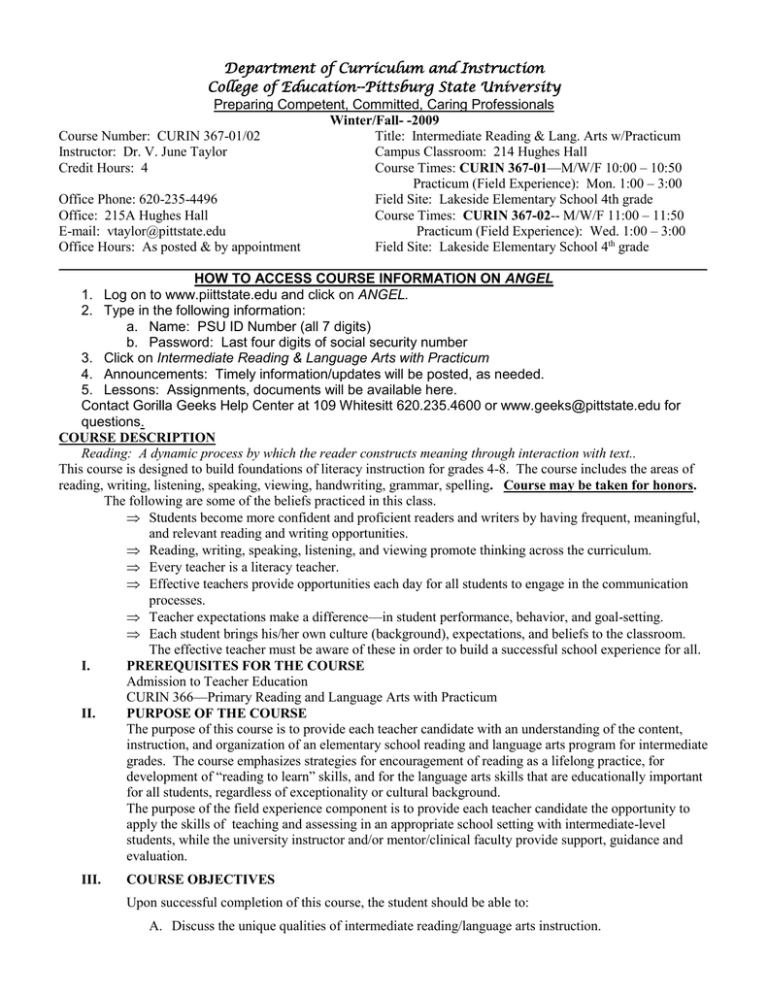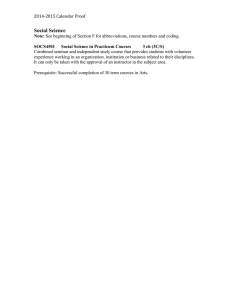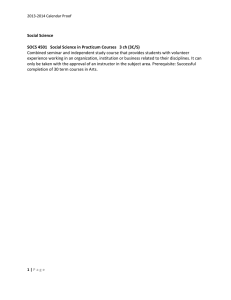CURIN 367
advertisement

Department of Curriculum and Instruction College of Education--Pittsburg State University Preparing Competent, Committed, Caring Professionals Winter/Fall- -2009 Course Number: CURIN 367-01/02 Title: Intermediate Reading & Lang. Arts w/Practicum Instructor: Dr. V. June Taylor Campus Classroom: 214 Hughes Hall Credit Hours: 4 Course Times: CURIN 367-01—M/W/F 10:00 – 10:50 Practicum (Field Experience): Mon. 1:00 – 3:00 Office Phone: 620-235-4496 Field Site: Lakeside Elementary School 4th grade Office: 215A Hughes Hall Course Times: CURIN 367-02-- M/W/F 11:00 – 11:50 E-mail: vtaylor@pittstate.edu Practicum (Field Experience): Wed. 1:00 – 3:00 Office Hours: As posted & by appointment Field Site: Lakeside Elementary School 4th grade ______________________________________________________________________________________________ HOW TO ACCESS COURSE INFORMATION ON ANGEL 1. Log on to www.piittstate.edu and click on ANGEL. 2. Type in the following information: a. Name: PSU ID Number (all 7 digits) b. Password: Last four digits of social security number 3. Click on Intermediate Reading & Language Arts with Practicum 4. Announcements: Timely information/updates will be posted, as needed. 5. Lessons: Assignments, documents will be available here. Contact Gorilla Geeks Help Center at 109 Whitesitt 620.235.4600 or www.geeks@pittstate.edu for questions. COURSE DESCRIPTION Reading: A dynamic process by which the reader constructs meaning through interaction with text.. This course is designed to build foundations of literacy instruction for grades 4-8. The course includes the areas of reading, writing, listening, speaking, viewing, handwriting, grammar, spelling. Course may be taken for honors. The following are some of the beliefs practiced in this class. Students become more confident and proficient readers and writers by having frequent, meaningful, and relevant reading and writing opportunities. Reading, writing, speaking, listening, and viewing promote thinking across the curriculum. Every teacher is a literacy teacher. Effective teachers provide opportunities each day for all students to engage in the communication processes. Teacher expectations make a difference—in student performance, behavior, and goal-setting. Each student brings his/her own culture (background), expectations, and beliefs to the classroom. The effective teacher must be aware of these in order to build a successful school experience for all. I. PREREQUISITES FOR THE COURSE Admission to Teacher Education CURIN 366—Primary Reading and Language Arts with Practicum II. PURPOSE OF THE COURSE The purpose of this course is to provide each teacher candidate with an understanding of the content, instruction, and organization of an elementary school reading and language arts program for intermediate grades. The course emphasizes strategies for encouragement of reading as a lifelong practice, for development of “reading to learn” skills, and for the language arts skills that are educationally important for all students, regardless of exceptionality or cultural background. The purpose of the field experience component is to provide each teacher candidate the opportunity to apply the skills of teaching and assessing in an appropriate school setting with intermediate-level students, while the university instructor and/or mentor/clinical faculty provide support, guidance and evaluation. III. COURSE OBJECTIVES Upon successful completion of this course, the student should be able to: A. Discuss the unique qualities of intermediate reading/language arts instruction. B. C. D. E. Describe the basic characteristics of a successful intermediate reading/language arts program. Recognize the role of literature as part of the total classroom experience. Enjoy and understand literature through classroom interaction and experience. Discuss and apply the characteristics and roles of informal, formal, and authentic assessment for intermediate students. F. Develop activities that promote writing skills and appreciation. G. Discuss, develop, and utilize process writing skills H. Assess and evaluate writing based upon identified components of effective writing. I. Recognize, discuss, and assess various components of commercial reading products/programs. J. Identify, discuss, and interact with the elements of literature. K. Develop/practice cursive writing abilities L. Recognize levels of comprehension and utilize appropriate strategies for building comprehension across the curriculum. M. Discuss and develop strategies and activities for teaching literary and content area vocabulary. N. Learn and practice strategies appropriate for individual, small group and whole group activities. O. Recognize the similarities among exceptional and non-exceptional students. P. Recognize reading motivation, attitude, and interest as powerful factors in developing lifelong readers. Q. Increase awareness of and develop competencies for educational needs of children from backgrounds of poverty. PSU Teacher Education Effectiveness Knowledge Base PROFESSIONAL CHARACTERISTICS 1. Is dependable and punctual. 2. Maintains a consistently pleasant, positive, and professional demeanor. 3. Believes that all students can learn and that, as a teacher, he/she can make a significant contribution to their learning. 4. Understands and respects a diverse student/parent population and has a goal to help all children learn respect for the traditions and cultures of others. 11. Communicates fluently using appropriate and grammatically correct oral and written language. 12. Sets goals and directions, which demonstrate the desire for lifelong learning (e.g. in-service, peer collaboration, professional readings.) 13. Demonstrates a desire to continually acquire knowledge and skills in emerging educational technologies. 14. Seeks to implement the recommendations from evaluations of his/her personal performance. 15. Participates in self-evaluation and reflection to enhance competence in instructional effectiveness. RELATIONSHIPS WITH STUDENTS 16. Conveys high expectations that all students will succeed and learn. 17. Models cheerful, supportive, enthusiastic behaviors, which convey a caring, equitable attitude towards all students. 18. Develops positive rapport with students by being empathetic, firm, fair, and appropriately friendly. 19. Listens carefully to all students then responds in a professional manner. INSTRUCTIONAL PLANNING 22. Understands the appropriate scope and sequence of objectives for teaching the curriculum. 23. Develops clear short and long-term instruction plans (e.g. lesson plans, units, and/or modules) which include objectives, materials, activities, and evaluation techniques based on the curriculum objectives. 24. Has an up-to-date knowledge of the subject matter and attempts to incorporate diverse and practical illustrations, examples and applications in lesson material and activities. 25. Selects materials and activities consistent with the objectives of the lesson and the students’ prerequisite skills, attention span, and learning styles. 27. Reflects an understanding of learning theory and knowledge of human development in planning for developmentally appropriate instruction. INSTRUCTION 29. Conducts class with poise, confidence, and enthusiasm. 30. Presents lessons in a clear, logical, and sequential manner. 31. Insures that lesson materials and information are professionally displayed and accessible to all students. 32. Communicates clearly to all students the objective and purpose of each lesson. 33. Reviews or provides an anticipatory set in an effort to provide lesson continuity and/or to gain the interest of the student for each lesson. 34. Makes the lesson relevant and meaningful for all students by relating it to real world situations. 35. Utilizes various instructional strategies appropriate for the objectives of the lesson. 36. Uses suitable teaching strategies to accommodate learning styles. 37. Incorporates individualized strategies for students with special needs (e.g., English as a second language, learning disabled, behavioral disordered). 39. Encourages participation from all students through effective questioning strategies (e.g., equal distribution, level variation, adequate wait time, probing and clue giving, and appropriate correctives and feedback). 40. Responds to student questions in a concerned and effective manner. 41. Provides opportunities for all students to successfully apply or practice knowledge and skills learned. 43. Conducts lessons at an appropriate pace so all students have the opportunity to learn the intended objectives. 44. Provides focus on important points and checks for understanding. 45. Accomplishes smooth and orderly transitions between parts of the lesson. 46. Gives clear directions. 48. Effectively achieves closure to each lesson and/or class period. 49. Provides instruction that maximizes time on appropriate tasks by keeping all students involved in learning. 50. Demonstrates flexibility in teaching techniques, as the situation requires. 51. Encourages and facilitates opportunities for students to think creatively and critically, to solve problems, and to develop the skills needed to live, learn, and work in a global society. CLASSROOM MANAGEMENT 53. Believes in and communicates a well-defined classroom management system. 55. Establishes, teaches, and reinforces classroom expectations, rules, routines, and procedures fairly and with an awareness of cultural attitudes and mores. 56. Monitors and keeps track of all student behavior and activities in the classroom at all times. 58. Handles multiple tasks, intrusions, and distractions while maintaining momentum and smoothness in the lesson. 60. Analyzes classroom problems and resourcefully seeks strategies to help develop a learning environment which encourages self-management, social interaction, high time-on-task, and active engagement. EVALUATION 64. Routinely uses a number of different techniques to assess the students’ understanding of material as it is taught. 65. Makes changes in instruction based on feedback from multiple classroom assessment sources. IV. REQUIRED TEXT AND MATERIALS a. Literacy for the 21st Century: Teaching Reading and Writing in Grades 4 through 8 (Topkins, 2004) b. Kansas Reading and Writing Stands for grade level appropriate for course use NOTE: Teacher Candidates may down load these documents, as needed. c. Put Reading First (booklet) NOTE: May have from Primary Reading course. Also available for checkout from CURIN 367 course instructor. HIGHLY RECOMMENDED: 3-ring notebook to organize course & practicum materials. Other Recommended PROFESSIONAL TEXTS AND MATERIALS * Yopp & Yopp. Literature-Based Reading Activities, (4th ed.) Atwell, N. (2002). Lessons that change writers. Portsmouth, NH: Heinemann. Davis, T. (2007). Prerootixx: morphemic analysis Payne, Ruby (2005). A Framework for understanding poverty. Highlands, TX: aha! Process, Inc. Routman, R. (2002). Reading essentials: The specifics you need to teach reading well. Routman, R. (2004). Writing essentials: Raising expectations and results while simplifying teaching. V. INSTRUCTIONAL RESOURCES Various texts/materials/periodicals/appropriate literature from Instructional Resource Center, Axe Library, instructor’s office; appropriate web sites, etc. Recommended Online Sources Criteria for evaluation of Internet Information Resources http://www.vuw.ac.nz/staff/alastair_smith/evaln/index.htm Lesson planning across grade levels and curriculum http://www.Read/WriteThink.org Literacy For The 21st Century Teaching Reading and Writing in Grades 4 Through 8 www.prenhall.com/tompkins The Newbery Medal, named for eighteenth-century British bookseller John Newbery, is awarded annually by the Association for Library Service to Children, a division of the American Library Association, to the author of the most distinguished contribution to American literature for children. http://www.ala.org/ala/alsc/awardsscholarships/literaryawds/newberymedal/newberymedal.htm VI. TEACHING STRATEGIES Lecture and demonstrations Discussions Oral & choral reading Audio/video materials Student presentations Peer evaluation e-mail and Internet Student conferences Independent reading from professional sources Individual, partner, small group, large group activities VII. COURSE REQUIREMENTS AND EVALUATION A. ATTENDANCE, PUNCTUALITY, PARTICIPATION NOTE WELL: Attendance, punctuality, participation are vital! Excessive absences (more than 4) may result in a “drop” from the course. Prompt arrival for each class period is expected. Three tardies are the equivalent of one absence. Classroom activities are vital to the learning process. Points awarded for participation and quizzes are earned only through class attendance. NOTE WELL: Students may NOT miss fieldwork days except for emergencies. This is a professional placement with important elementary class time and elementary students provided to PSU teacher candidates for their field activities. ***This attendance policy is not about “punishment.” It is about effectively preparing future teachers with the information, concepts, and skills of this course.** B. EXPECTATIONS OF PROFESSIONALISM Students are expected to maintain a professional attitude and demeanor at all times. Examples of professional attitude/demeanor include the following: showing respect by being attentive to the instructor and classmates; participating in class activities ; being punctual and remaining until class is dismissed; maintaining a positive attitude. NOTE: A professional dress code for field site appearance will be provided, discussed, and followed. C. ACADEMIC HONESTY: All assignments must be the student’s own original work. Teacher candidates are expected to follow the PSU Academic Honesty Policy, which speaks to unethical acts associated with coursework or grades. The policy lists specifically, but is not limited to, the following: *Giving or receiving unauthorized aid on examinations, preparation of notebooks, papers, etc.. *Handing in the same work for more than one course without instructor permission. *Engaging in plagiarism including the use of part or all of someone else’s written or spoken ideas Full text of the policy can be found in the PSU University Catalog D.SCORING AND POSTING: NOTE WELL: All assignments are to be submitted on designated due dates with high-quality content and format. Correct spelling, proper grammar, clarity of thought are expected. Word processing is required, unless noted. Class quizzes/participation points are earned only during class periods in which they occur. Accomplishment of course requirements will be determined formatively and summatively through a point system. Each requirement is assigned a predetermined point value. Final grade is determined by total points from class participation, in-class quizzes, and from the assignments and exams detailed in this syllabus for course and practicum. GRADING SCALE: 90-100%-A, 80-89%-B, 70-79%-C, 60-69%-D, Below 60%-F ASSIGNMENTS, ACTIVITIES, EXAMS NOTE: Additional information and evaluation criteria will be provided during class sessions. CLASS ASSIGNMENTS/PROJECTS Literacy Autobiography/Self-Introduction (Choice of Projects) Literacy Strategy Presentation w/Partner(s) & Reflection Independent Reading & Peer Recommendation “Cards” Interm. Level books -- 2 fiction, 1 non-fiction Process Writing Lesson Plan Language Arts Activity—Web-Based w/Partner(s) Content Area Lesson Plan Student Interactive Author Center In-class participation activities FIELD EXPERIENCE EVALUATION: Instructor Evaluation of Interaction/Goal Attainment (Minimum 3 during semester) Practicum Experience Reflections (bi-weekly or as required) 15 points 15 points 15 points each-45 pts total 25 points 15 points 25 points 50 points Varied points 15 points each 10 points each TEXT QUIZZES & COURSE EXAMS: Text quizzes and/or preview/review questions Varied Mid-Term 25 points Final Exam (Comprehensivc) 50 points NOTE: FINAL (Final will be administered according to the PSU exam schedule. EXTRA CREDIT OPPORTUNITIES: Book in Box Project (Information provided) 10 pts possible Book Talk (from Independent Reading) 10 pts possible Requirements subject to change for teacher candidate learning needs, field site needs, time constraints. SPECIAL CONCERNS: This message is from the Learning Center Director (620) 235-4309: Any student who, because of a disabling condition, may require some special arrangements in order to meet course requirements should contact the Learning Center as soon as possible to make necessary accommodations. COURSE CONTENT from TOMPKINS TEXT (See Semester Schedule for exact order of units/chapter readings.) A. Becoming an Effective Teacher of Reading – Chapter 1 B. Teaching the Reading and Writing Processes – Chapter 2 C. Assessing Students’ Literacy Development – Chapter 3 D. Refining Students’ Print Skills – Chapter 4 E. Learning about the Meaning of Words – Chapter 5 F. Comprehension – Chapter 6 G. Structure of Text – Chapter 7 H. Teaching with Narrative Texts – Chapter 8 I. Teaching with Content Area Textbooks – Chapter 9 J. Connecting Reading and Writing – Chapter 10 K. Working with Struggling Readers and Writers – Chapter 11 L. Becoming Lifelong Readers and Writers – Chapter 12 Let the Learner enjoy the Learning!


